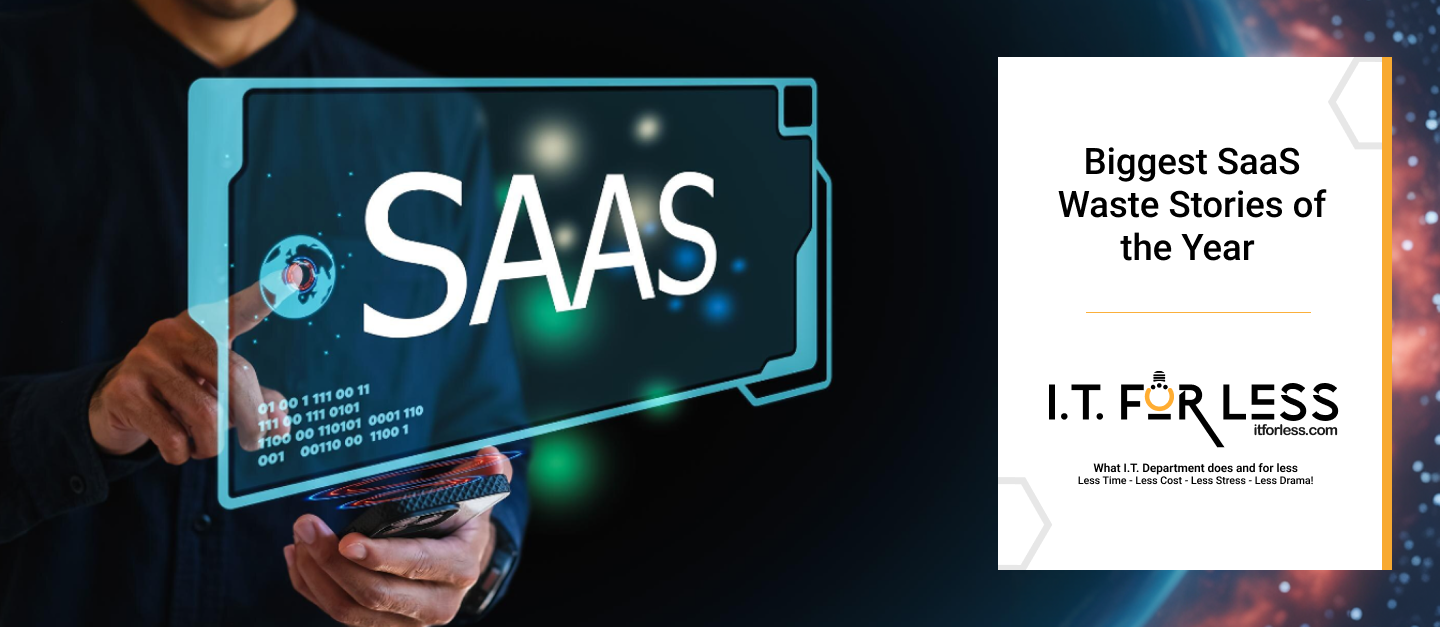Every year, companies across industries lose millions of dollars to one of the most invisible yet costly problems in IT: SaaS waste.
Whether it’s unused licenses, duplicate subscriptions, or forgotten renewals, SaaS waste continues to drain budgets and frustrate leadership teams. At I.T. For Less, we’ve seen the good, the bad, and the truly unbelievable.
Here are the biggest SaaS waste stories of the year, what we learned from them, and how your business can avoid the same fate.
1. The $250,000 Collaboration Tool That No One Used
Industry: Healthcare SaaS provider
Size: 500 employees
A growing healthcare tech company onboarded a new collaboration suite with all the bells and whistles: secure file sharing, team messaging, video meetings, task management — you name it. The vendor offered an annual enterprise license with a volume discount.
Twelve months later, their IT team noticed no one had migrated to the new platform. Why? Employees were still using Slack and Google Drive.
The Result:
- $250,000 in sunk costs
- Zero ROI
- One very awkward budget meeting
What Went Wrong:
- No internal rollout or training plan
- Overlapping tools not phased out
- Poor change management
2. The Marketing Department’s Secret Stash
Industry: E-commerce
Size: 300 employees
While conducting a SaaS audit, we discovered that the marketing team had subscribed to 11 different analytics platforms, many of which had overlapping functionality.
The kicker? Several were being paid for via personal credit cards and expensed monthly, bypassing IT.
The Result:
- $40,000/year in redundant tools
- Unmonitored access to customer data
- Security and compliance risks
What Went Wrong:
- Lack of centralized procurement
- No policy on software approval
- Shadow IT running rampant
3. The Forgotten HR Tool on Auto-Renew
Industry: Professional services
Size: 80 employees
An HR manager had implemented a payroll and performance tracking SaaS tool but left the company before fully rolling it out. The system remained on autopilot — auto-renewing every year.
It wasn’t until the finance team did a line-by-line budget review that the charge was flagged.
The Result:
- $30,000 lost over 3 years
- No one in the company even had the login
What Went Wrong:
- No centralized SaaS inventory
- Incomplete offboarding process
- No renewal alerts or oversight
4. The IT Team That Bought Twice
Industry: Education technology
Size: 1,000+ employees
Two IT admins, working in different departments, each bought licenses for the same identity management tool. Neither realized the other had already signed a contract.
Each thought they were getting a “great deal.”
The Result:
- Duplicate contracts
- 2x support costs
- Confused users with dual logins
What Went Wrong:
- No cross-departmental communication
- Decentralized purchasing
- No system of record for SaaS
5. The Startup That Outgrew Its SaaS Stack — But Didn’t Know It
Industry: SaaS startup
Size: 150 employees
Startups move fast. This one moved too fast. As the company scaled, it layered on new tools for HR, CRM, customer support, marketing automation, and product feedback. But no one ever revisited the old tools.
By the time they hit 150 employees, over 60% of their SaaS stack was redundant, unused, or outgrown.
The Result:
- $120,000/year in avoidable costs
- Fragmented systems and frustrated users
What Went Wrong:
- No SaaS audit process
- Tool sprawl without standardization
- No lifecycle management
What These Stories Teach Us
Every one of these situations was preventable. The root causes were different — lack of oversight, poor communication, missing processes — but the result was the same: wasted money, unnecessary risk, and missed opportunity.
Here are the key takeaways:
1. Always Centralize SaaS Purchasing
Whether through IT, procurement, or a SaaS manager, all software buying should be visible and approved.
2. Maintain a Real-Time SaaS Inventory
Track every app, user, license count, renewal date, and owner.
3. Monitor Usage
If no one is logging in, you shouldn’t be paying for it.
4. Set Clear Onboarding and Offboarding Workflows
Ensure SaaS accounts are added and removed as employees join or leave.
5. Review Your Stack Regularly
At least quarterly, review what tools are in use, what can be consolidated, and what should be eliminated.
How I.T. For Less Can Help
If any of these stories hit a little too close to home, don’t worry — we’re here to help.
I.T. For Less offers:
- SaaS waste audits
- License optimization
- Shadow IT detection
- SaaS management setup and training
- On-demand SaaS administrator support
Our goal is simple: More expertise. Less hassle.
Final Thoughts
SaaS waste isn’t just a finance issue — it’s a business issue. And the longer it goes unaddressed, the more it costs.
By learning from the biggest SaaS waste stories of the year, you can turn your software strategy into a smart investment — not a silent leak.
Want to make sure your company doesn’t make next year’s list? Contact I.T. For Less today.
📧 Contact us | 📞 Schedule a Free Consultation | 🌐 www.itforless.com
